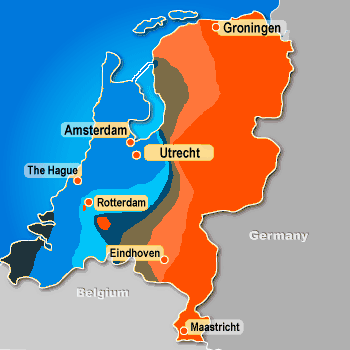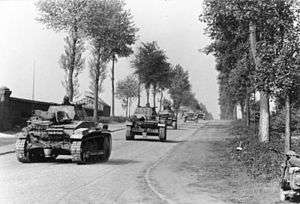On the Morning of May 10, 1940, the German military advanced into the Netherlands, Belgium and Luxembourg. Luxembourg fell in about 5 hours, with little resistance.
The Netherlands
Hitler had expected to conquer the Netherlands within a day. German airborne units were sent behined the lines, one group to capture airfields outside the Hague, and the other to capture key bridges in the vincity of Rotterdam. The Battle for the Hague, was an absolute failure for the Germans. the airfield were taken with heavy casualties, only to be retaken later in the day by the Dutch, forcing the Germans to flee into nearby woods. The Luftwaffe lost 125 transport planes, representing 50% of the fleets strength.
At Rotterdam, the Germans were much more successful. The Dutch soilders were taken offguard, and the bridges fell into German hands. The reason for capturing the bridges was so the advancing tanks could cross into Rotterdam when they arrived.

In the North the Germans were stopped at the Afsluitdijk, a chain of defences protecting the Afsluitdijk dike. In the center, the main Dutch defence was the Grebbline. The Germans reached in on the 10th, but it was not until the 14th that the Dutch were forced to evacuate into Fortress Holland, the last Dutch defence line.
In the south the German achieved the most succes. They quickly advanced towards Rotterdam. On the 14th the Dutch and Germans were fighting through the streets of the city, and later the Dutch surrendered the city after hearning that the Germans were going to bomb the city. However, for unknown reasons, the German planes on the way to bomb this city never got the message, and some 900 civilians were killed.
On the evening of the 15th, the Dutch Army was still largely intact, however, their strategic situation had become hopeless. At 9:00pm, the Netherlands surrendered. However, in the Dutch province of Zeeland, the remaining Dutch and French troops, who had just arrived, would hold out until the 17th.
Belgium

The Germans quickly, once again, established Air Superiority over Belgium. On the first day of battle they destroyed almost half of the planes in the Belgian Air Force.
The main problem the Germans faced advancing into Belgium was Fort Eben-Emael, a large fortress then generally considered the most modern in the world, controlling the junction of the Meuse and the Albert Canal. To overcome this problem, the Germans landed gliders on top of the fort filled with German assault infantry, and blew up the main gun cupolas with hollow charges. The bridges over the canal were seized by German paratroopers. Shocked by a breach in its defences just where they had seemed the strongest, the Belgian Supreme Command withdrew its divisions to the KW-line five days earlier than planned.
The arrival of French tanks, resulted in the Battle of Hannut, which up to that time, was the largest tank battle in history. However, the French were forced off the battlefield. Following this battle, Belgium was overrun, and on May 27th, surrendered to Germany.